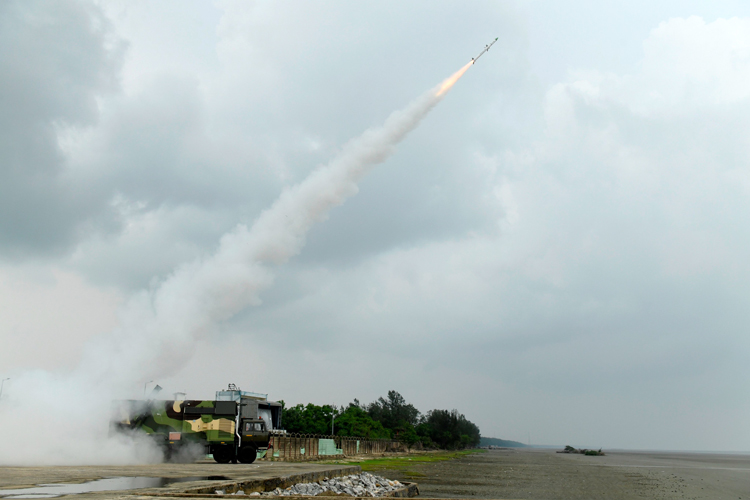INDIAN ARMED FORCES CHIEFS ON OUR RELENTLESS AND FOCUSED PUBLISHING EFFORTS

The insightful articles, inspiring narrations and analytical perspectives presented by the Editorial Team, establish an alluring connect with the reader. My compliments and best wishes to SP Guide Publications.

"Over the past 60 years, the growth of SP Guide Publications has mirrored the rising stature of Indian Navy. Its well-researched and informative magazines on Defence and Aerospace sector have served to shape an educated opinion of our military personnel, policy makers and the public alike. I wish SP's Publication team continued success, fair winds and following seas in all future endeavour!"

Since, its inception in 1964, SP Guide Publications has consistently demonstrated commitment to high-quality journalism in the aerospace and defence sectors, earning a well-deserved reputation as Asia's largest media house in this domain. I wish SP Guide Publications continued success in its pursuit of excellence.
- Global Partners Urged to Tap India's Shipbuilding Potential: Rajnath Singh at Samudra Utkarsh
- All about HAMMER Smart Precision Guided Weapon in India — “BEL-Safran Collaboration”
- India, Germany deepen defence ties as High Defence Committee charts ambitious plan
- G20 Summit: A Sign of Global Fracture
- True strategic autonomy will come only when our code is as indigenous as our hardware: Rajnath Singh
- India–Israel Joint Working Group Meeting on defence cooperation to boost technology sharing and co-development
Atmanirbhar in Defence
“The biggest lesson is that we have to be ready to fight future wars with indigenous weapons and the steps towards Atmanirbhar Bharat in defence should be taken more urgently” —General Manoj Mukund Naravane, Chief of the Army Staff
 |
The Author is Former Director General of Information Systems and A Special Forces Veteran, Indian Army |

Amid the ongoing Russia-Ukraine conflict, Army Chief General Manoj Mukund Naravane speaking to the media on March 8, 2022, said, “The biggest lesson is that we have to be ready to fight future wars with indigenous weapons and the steps towards Atmanirbhar Bharat in defence should be taken more urgently. The wars of the future should be fought with our own weapon systems.” He also said that one more major lesson is that wars can happen anytime and we have to remain prepared for them.
Fallout of the Ukraine conflict on India’s defence preparedness is being monitored by the Armed Forces, including supply of defence equipment and spares from Russia and Ukraine. Russian missile and artillery strikes on Ukrainian factories of aircraft manufacturer Antonov and gas turbine maker Zorya-Mashproekt are of concern to the Indian Navy (IN) and the Indian Air Force (IAF) though there is no cause for immediate worries with adequate spare parts stocked. But supply from Ukraine may be affected in the long run.
Fallout of the Ukraine conflict on India’s defence preparedness is being monitored by the Armed Forces, including supply of defence equipment and spares from Russia and Ukraine.
The IN depends heavily on Ukraine for Zorya-Mashproekt gas turbine engines to power many of its surface ships including the Talwar-class stealth frigates and Delhi-class destroyers. India had already procured gas turbine engines from Ukraine for the two Admiral Grigorovich-class guided-missile stealth frigates being built in a Russian shipyard for the IN as part of a $2.5 billion deal.
Former Chief of Naval Staff, Admiral Arun Prakash has tweeted, “Given the Indian Navy’s large holdings of Ukrainian marine gas turbines, which power Indian destroyers, frigates and corvettes, this is an opportune moment to seriously consider a Hindustan Aeronautics Limited (HAL)/ ZoryaMashproekt joint venture to manufacture them in India”.
The IAF operates over 100 x An-32 aircraft manufactured by Antonov, which are in final stages of an upgrade. In 2008, India signed a $400 million contract with Ukraine to upgrade 105 x AN-32 aircraft. 45 aircraft were upgraded in Ukraine and balance was to be upgraded in India. But the project got delayed due to breakdown of Ukraine-Russia ties over Russia’s annexation of Crimea in 2014 and Russia’s refusal to supply Ukraine with critical equipment for the retrofit.
With the India-US 2+2 Dialogue slated in early April, India should expect to be pressured to purchase more American and European weapon systems
Russian strikes in Ukraine focused on destroying Ukraine’s aircraft; 98 destroyed according to the Russian statement. The military-industrial complex perhaps suffered collateral damage, which may or may not be severe. But when the war in Ukraine will end is difficult to predict since the west continues to pump arms, money and proxy forces in Ukraine. Moreover, Scott Ritter, former Marine Corps Admiral and Intelligence Officer, has gone public that the CIA and MI-6 have been training neo-Nazis in Azov. That is why Russia struck Ukraine’s Yavoriv military base, 19 km from the Polish border, claiming 180 foreign mercenaries under training were killed.
With the India-US 2+2 Dialogue slated in early April, India should expect to be pressured to purchase more American and European weapon systems, as is apparent from the recent statements of America’s Assistant Secretary of Defence for Indo-Pacific Security Affairs, Ely Ratner to the US House Armed Services Committee and of Admiral John Aquilino, Commander of US Indo-Pacific Commandto theSenate Armed Services Committee. But it would be prudent for India to keep imports, if any, to the barest minimum, instead focusing on Make in India and indigenisation. This is essential since the US has the history of using and dropping nations when it wants.


Apprehensions continue that India’s problem will grow worse if the US imposes sanctions on under its Countering America’s Adversaries Through Sanctions Act (CAATSA). However, it is time for India to call the bluff of American sanctions. India’s strength is its population and market and if the deals with Russia are not in dollars, the US has no business to interfere. Bangladesh has already told the US it will continue trading with Russia despite sanctions.
Media reports indicate that the Armed Forces have been holding meetings with different suppliers and stakeholders to equip themselves from other sources. Efforts are also being made to ensure that whatever possible content can be indigenised, is done on war footing. At the same time, we must be ready for sudden flare ups along the Line of Actual Control, with an unpredictable China and the 13th, 14th and 15th round of military-to-military talks over the standoff in Eastern Ladakh having made no progress.
Efforts are also being made to ensure that whatever possible content can be indigenised, is done on war footing
We need to take a holistically serious look at our indigenisation targets, given that we have more than enough talent in the country provided we know how to integrate and optimise it. It may be said that this is already being done but why it is not enough can be gauged by following two examples:
- Why is our indigenous drone industry in such a poor state, compared not only to China but also Turkey whose armed drones played havoc in the Armenia-Azerbaijan war over Nagorno Karabakh and are being used in the current Ukraine conflict by Ukrainians?
- Even before Dr A.P.J. Abdul Kalam became President of India, he had identified four technology voids without which India can’t become a super power. One of these was engine technology. Why have we not reached a stage where we don’t import engines and export them? Why have we not even attempted reverse engineering?
Reasons for the above are known, some being:
- The governmental defence-industrial sector takes precedence over the private sector whereas need of the hour is to reverse it.
- Reorganisation of the Ordnance Factory Board (OFB) and 41 Ordnance Factories (OF) into Defence Public Sector Undertakings (DPSUs) with the same governance, staff and work culture, instead of privatising them, was a superficial exercise.
- Major portion of the Defence Research and Development OrganiSation (DRDO), if not all, needs to be privatised.
- Attaching start ups and MSMEs to the DRDO and/or DPSUs prevents them from optimising their own initiative.
- Issuing periodic lists of items banned from imports without ensuring these are produced in sufficient numbers to meet operational requirements may earn brownie points with the Prime Minister but is fooling ourselves.
- Like all governments, the current one remains hostage to the bureaucracy - bureaucracy has actually expanded under the present government.
- In absence of a national security strategy and comprehensive defence review, do we really know what we need to defend India?
Unless the above issues are addressed, we will be shadow boxing with Atmanirbhar in defence.





